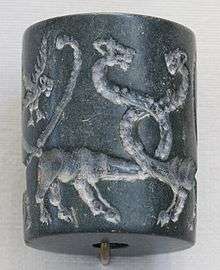Halaf-Ubaid Transitional period
| Geographical range | Mesopotamia |
|---|---|
| Period | Neolithic 3 – Pottery Neolithic (PN) |
| Dates | circa 5,500 B.C.E. — circa 5,000 B.C.E. |
| Type site | Tepe Gawra |
| Preceded by | Halaf culture |
| Followed by | Ubaid period |
The Halaf-Ubaid Transitional period (ca. 5500/5400 to 5200/5000 BC) is a prehistoric period of Mesopotamia. It lies chronologically between the Halaf period and the Ubaid period. It is a very poorly understood period and was created to explain the gradual change from Halaf style pottery to Ubaid style pottery in North Mesopotamia.[1]
Archaeology
Archaeologically the period is defined more by absence than data as the Halaf appears to have ended before 5500/5400 cal. BC and the Ubaid begins after 5200 cal. BC. There are only two sites that run from the Halaf until the Ubaid. The first of these, Tepe Gawra, was excavated in the 1930s when stratigraphic controls were lacking, causing difficulties in re-creating the sequence.[2] The second, Tell Aqab remains largely unpublished.[3] This makes definitive statements about the period difficult and with the present state of archaeological knowledge nothing certain can be claimed about the Halaf-Ubaid transitional except that it is a couple of hundred years long and pottery styles changed over the period.
Notes
- ↑ Campbell, Stuart and Fletcher, Alexandra. 2010. Questioning the Halaf-Ubaid Transition in Carter, Robert and Philip, Graham Beyond the Ubaid: Transformation and Integration in the Late Prehistoric Societies of the Middle East Chicago: The Oriental Institute of the University of Chicago. ISBN 978-1-885923-66-0. Available at http://oi.uchicago.edu/research/pubs/catalog/saoc/saoc63.html (Accessed 25/07/2013). pp. 79-80.
- ↑ Campbell, Stuart and Fletcher, Alexandra. 2010. Questioning the Halaf-Ubaid Transition in Carter, Robert and Philip, Graham Beyond the Ubaid: Transformation and Integration in the Late Prehistoric Societies of the Middle East Chicago: The Oriental Institute of the University of Chicago. ISBN 978-1-885923-66-0. Available at http://oi.uchicago.edu/research/pubs/catalog/saoc/saoc63.html (Accessed 25/07/2013). pp. 77.
- ↑ Campbell, Stuart and Fletcher, Alexandra. 2010. Questioning the Halaf-Ubaid Transition in Carter, Robert and Philip, Graham Beyond the Ubaid: Transformation and Integration in the Late Prehistoric Societies of the Middle East Chicago: The Oriental Institute of the University of Chicago. ISBN 978-1-885923-66-0. Available at http://oi.uchicago.edu/research/pubs/catalog/saoc/saoc63.html (Accessed 25/07/2013). pp. 77
References
- Davidson, T and Watkins, T. 1981. 'Two seasons of excavation at Tell Aqab in the Jezirah, N.E. Syria' Iraq. 43:1. pp. 1–18.
- Tobler, Arthur. 1950. Excavations at Tepe Gawra: Volume II. Oxford: Oxford University Press.
- Campbell, Stuart and Fletcher, Alexandra. 2010. Questioning the Halaf-Ubaid Transition in Carter, Robert and Philip, Graham Beyond the Ubaid: Transformation and Integration in the Late Prehistoric Societies of the Middle East Chicago: The Oriental Institute of the University of Chicago. ISBN 978-1-885923-66-0. Available at http://oi.uchicago.edu/research/pubs/catalog/saoc/saoc63.html (Accessed 25/07/2013)
- Campbell, Stuart. 2007. 'Rethinking Halaf chronologies' Paléorient. 33:1. pp. 103–136.


